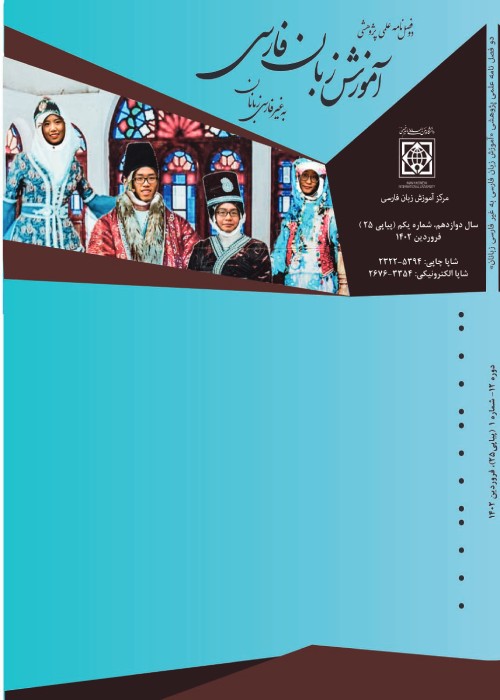Production of Persian Low Vowels by Japanese Learners of Persian
Author(s):
Article Type:
Research/Original Article (دارای رتبه معتبر)
Abstract:
Persian has two low vowels, namely, the front vowel /a/ and the back vowel /ɒ/, while Japanese has only one low vowel which is phonologically a back vowel, but phonetically a central one. In the present study, the research question is whether Japanese learners of Persian language are able to produce the Persian front and back low vowels distinctively or not. In order to answer this question, Japanese learners of Persian language were asked to produce Persian and Japanese low vowels in the target words. Native speakers of Persian also produced the same Persian words. Then, the frequency of the first and the second formants (F1 and F2) of low vowels were measured.Thefrequency of the first and the second formants of Persian low vowels in the Japanese learners’ production were compared to that of the Persian native speakers. The statistical analyses revealed that Japanese learners produce the two Persian low vowels without a significant difference and almost similar to the Japanese low vowel. Extended abstractPersian has two low vowels, namely, the front vowel /a/ and the back vowel /ɒ/, while Japanese has only one low vowel which according to (Labrune, 2012) and (Kubozono, 2015) is phonologically a back vowel, but phonetically a central one. When Japanese native speakers learn Persian as a foreign language, they tend to map the high and the mid vowels of their language onto the high and the mid vowels of the target language due to the similarity between the number and the quality of these vowels. However, producing Persian low vowels is potentially problematic for Japanese native speakers since Japanese has only one low vowel while there are two low vowels in Persian. In the present study, the main research question was whether Japanese learners of Persian language are able to produce the Persian front and back low vowels distinctively or not. This study also tried to reveal the acoustic characteristics of the Persian low vowels produced by learners with Japanese L1. The findings of this research can be used in teaching Persian as a foreign language to native speakers of Japanese and specially in designing specific pronunciation drills for them. In order to answer the above questions, a production test was designed and conducted in which learners of Persian language with Japanese L1 produced Persian and Japanese words containing low vowels. Native speakers of Persian also produced the same Persian words. The vowels of both languages were presented in an unstressed position in disyllabic or trisyllabic words. In this experiment 12 participants (six Japanese speakers and six Persian speakers) took part. Persian speakers were learners of Japanese language in Iran, and had studied the language for two years in the university. Their age ranged from 20 to 22, with the average of 20.6 years. They were all classmates, and none of them had ever been to Japan. Japanese speakers had been studying Persian for at least two, and at most three years in Japanese universities. Their age ranged from 21 to 30 with the average of 24.5 years. They all had a 1-3 month stay in Iran. The utterances were recorded at a sampling frequency of 44,100 Hz in a phonetic laboratory and were analyzed using the phonetics software Praat (Boersma&Weenink, David, 2019). Next, the frequency of the first and the second formants (F1 and F2) of Persian low vowels produced by Japanese learners was measured based on the method explained in (Bijankhan, 2013, pp. 149-150) and was compared to the F1 and F2 of Persian low vowels produced by native speakers. The results of the measurements which are presented in the form of tables and graphs in the paper, suggest that although Persian native speakers produce the front and the back low vowels distinctly, Japanese learners of Persian produce the two Persian low vowels with a similar quality, i.e., with similar F2 amounts. In statistical analyses, first a Cronbach's alpha test was used to determine the internal consistency of the data. Then, a paired dependent samples t-test was used to determine if there were significant mean differences in F1 and F2 in subject groups. The inferential statistical analyses of the test results revealed that there is no significant difference between the F1 of Japanese and Persian low vowels produced by native speakers and language learners which was not surprising because all the vowels in question were low vowel. However, on the other hand, native speakers of Persian produced Persian low vowels with significantly different F2, while there was no significant difference between the F2 of Persian low front vowel and low back vowel produced by Japanese learners. In other words, when Japanese learners produce Persian low vowels, there is an overlap between the spaces of these two vowels. Comparisons between the F2 of Persian vowels produced by Japanese learners with the F2 of the Japanese low vowel showed that in fact, Japanese learners tend to produce both Persian low vowels similar to the low vowel in Japanese. In order to train the language learners in Japan to produce Persian low vowels distinctly, both traditional methods such as drills utilizing minimal pairs and new computer-assisted comparative methods such as sound visualization can be used.
Keywords:
Language:
Persian
Published:
Journal of Teaching Persian to Speakers of Other Languages, Volume:8 Issue: 17, 2019
Pages:
3 to 18
magiran.com/p2043491
دانلود و مطالعه متن این مقاله با یکی از روشهای زیر امکان پذیر است:
اشتراک شخصی
با عضویت و پرداخت آنلاین حق اشتراک یکساله به مبلغ 1,390,000ريال میتوانید 70 عنوان مطلب دانلود کنید!
اشتراک سازمانی
به کتابخانه دانشگاه یا محل کار خود پیشنهاد کنید تا اشتراک سازمانی این پایگاه را برای دسترسی نامحدود همه کاربران به متن مطالب تهیه نمایند!
توجه!
- حق عضویت دریافتی صرف حمایت از نشریات عضو و نگهداری، تکمیل و توسعه مگیران میشود.
- پرداخت حق اشتراک و دانلود مقالات اجازه بازنشر آن در سایر رسانههای چاپی و دیجیتال را به کاربر نمیدهد.
In order to view content subscription is required
Personal subscription
Subscribe magiran.com for 70 € euros via PayPal and download 70 articles during a year.
Organization subscription
Please contact us to subscribe your university or library for unlimited access!



